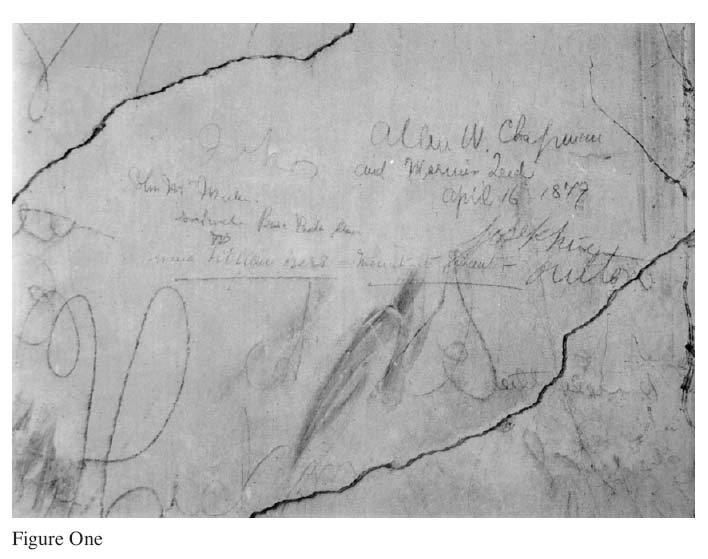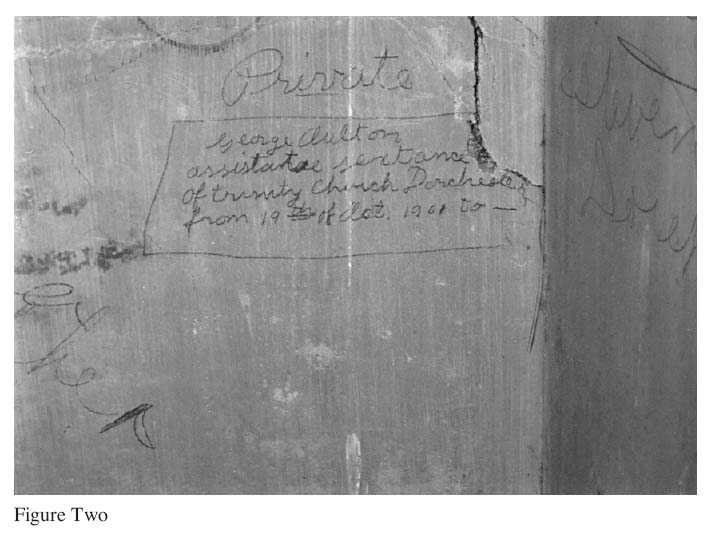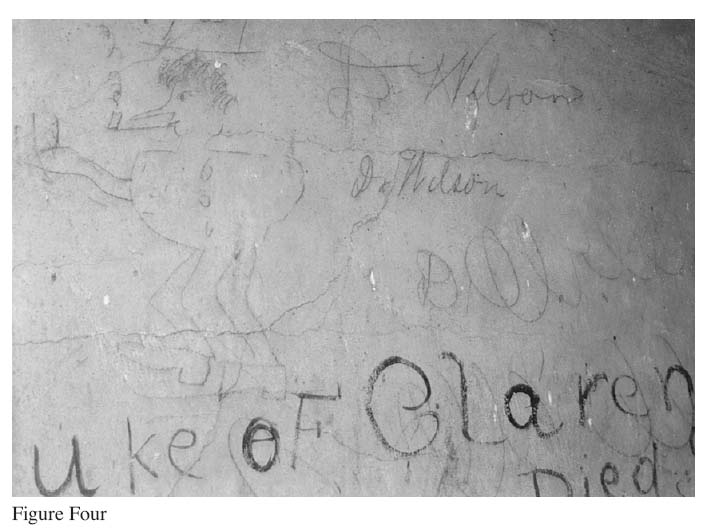Graffiti and Sacred Spaces:
Holy Trinity Anglican Church, Dorchester, N.B.
Laurie C.C. Stanley-BlackwellSt. Francis Xavier University
John D. Blackwell
Brandeis University
1 THE SOCIAL SIGNIFICANCE OF graffiti has in recent years captured the attention of anthropologists, folklorists, social psychologists, ethnographers and sociolinguistic researchers.2 However banal, generic or ephemeral, two prominent scholars observe, "the very pervasiveness of graffiti over time and space...entitles them to serious study as much as any other record" of human civilization. Such assumptions rest squarely on the premise that "every graffito can thus be seen and/or read as a miniature autobiography of a member of a society in the sense that the graffitist reveals a part of himself and his society in all that he writes".3
2 The historiography, which ranges from antiquarian to innovative, attempts to unveil the meanings of the style, content and communicative function of this idiom. Latrinalia, for instance, have generated so much academic scrutiny that they constitute a distinct subclass of graffiti research.4 Despite attempts to formalize a methodology for data collection and content analysis, however, the study of graffiti is fraught with problematic theorizing. Much of the literature focuses on formulating certain "motivational hypotheses" about the individuals and societal attitudes which produce wall inscriptions and drawings.5 Graffiti have been identified variously as a vernacular expression of anti-authoritarianism, repressed sexuality, adolescent aggression and artistic individualism.6 In recent years, the graffiti that adorn subways, public washrooms and back-alley walls have become the signature of lawlessness and counterculture. These sites are the canvases of the disfranchised as well as the anonymous artist armed with spray paint, pocket knife and pen. However, wall graphics are more than crude expressions of subversion, gang territoriality and vandalism. They represent an alternative medium of communication, and one of the intersections of art and politics.7
3 Graffiti are not solely a modern urban phenomenon. This "aspect of culture" is as old as humankind’s desire to communicate, for mural scripts date back to the cave interiors of prehistoric times.8 Classical antiquity also abounds with examples of graffiti: the walls of houses in Pompeii and Herculaneum offer a diverse tableau of graphic texts and caricatures ranging from the pornographic to the political.9 Historical evidence also points to more conventional and less clandestine purposes. For example, one scholar notes public authorities during classical times used this medium for official "service announcements".10 Early Christian churches also bear the imprint of graffiti, while such history-steeped buildings as the Tower of London are etched with the wall writings of cell-bound prisoners.11
4 Although classical historians have explored the symbolic dimensions of graffiti, the potential inherent in this artefact of popular creation has eluded the attention of Canadian historians. Let us consider the case of Holy Trinity Anglican Church in Dorchester, New Brunswick. Here there is tantalizing evidence of late 19th- and 20th-century graffiti which have escaped obliteration by scrub brush and paintbrush.
5 This frame white clapboard structure was built in 1840 and extensively renovated in 1880 and 1890.12 By 1891, the church with its fresh coat of paint, renovated belfry, new Gothic windows and pews, and memorial windows, was a respectable bastion of Anglicanism. Incorporating both Classical and Gothic elements, Trinity projects a dignified simplicity. Although the church fell short of Bishop John Medley’s Gothic vision for New Brunswick of soaring vaults and thrusting spires, Bishop John Inglis described Trinity, at the time of its consecration in 1843, as "a very neat church".13 Early in its history, the church boasted such refinements as an imported English organ; accordingly, writes H. M. Petchey, both "music and architecture gave praise to God". In fact, the service music "was far above the standard heard in the average parish church, reflecting the tradition of choir singing that the Yorkshire settlers brought from northern England to the Isthmus of Chignecto".14 The parish roll included shipbuilders, merchants, lumbermen, barristers and magistrates. In these ranks, a significant number of families such as the Chandlers, Teeds, Palmers, Gilberts, Hickmans and Chapmans were key players in Dorchester’s ascent as the aspiring shiretown of Westmorland County.15 The town served as an important political and legal centre, as well as an active participant in shipbuilding and the coastal trade.
6 The graffiti at Trinity Church are confined largely to a small, dimly-lit second-storey room, measuring approximately 2.1 by 6.4 metres; its height is only 2.6 metres. This austere, functional area, adjacent to the open gallery, is partially illuminated by the peaked tip of a Gothic window. There are no elaborate decorations, furnishings or designs imbued with Victorian, Neo-Gothic sensibility. The room is multi-purpose, serving both as storage space and robing chamber.
7 The room’s most notable feature is the thicket of markings dating from 1869 to 1991 which cover the plaster and wood walls, doors and door jambs. This visual maze of preponderantly male names and dates jostling for space is in places virtually indecipherable. Most of the wall writings are inscribed in pencil; a few are incised while more recent additions are rendered in chalk. It should be noted, as well, that graffiti are generally a very ephemeral form of textual evidence, so their survival over a long period and in such abundance is highly unusual. This evidence constitutes an important harvest to be reaped as historians look beyond conventional written and printed sources.16
8 However meaningful the setting of this graffiti, isolating its intended audience and motivating purpose presents unique challenges. The system of classification employed by Paul A. Erikson in Graffiti Halifax Style provides a useful organizational device. Much of the graffiti in Trinity’s robing room can be labelled as "signature graffiti" which identify authorship.17 The names are recorded as initials or printed or written in full. Typical examples include: "W.C.S.", "G.K.O.", "J.M."; all three sets of initials are enclosed in boxes. In another singular case, the name is printed boldly in capital letters ranging in size from 2.5 to 10.2 centimetres: "JOB STEVEN, DORCHESTER, NEW BRUNSWICK, CANADA, WESTMORLAND CO". Some individuals chose to record their names more than once. Alex Ward virtually appropriated the door leading to the church tower. These specimens of "signature graffiti" reveal little attempt to conceal identity. There are no nicknames, codes or cryptic symbolism. Presumably, the location was deemed safe for personal disclosure, and there was no opprobrium connected with authorship of inscriptions. Other examples provided additional identifying details such as dates and location: "Allen W. Chapman and Mariner Teed, April 16, 1879"; "D.F. Ives Pictou 1870"; "A.J. Hickman April 11 1869 Sunday"; "G.K. Oulton Dorchester NB Dec 15th 1901"; "Alex Ward Feb 19th/22 10 min to 7"; "Robert Palmer Jan 25/42 at 3 PM Dorchester New Brunswick" (see Figure One).
Figure One

Display large image of Figure 1
9 The psychosocial dynamics behind "signature graffiti" are obscure. Studies suggest that signature wall graphics proclaim "personal worth and identity by those whose lives seem worthless and anonymous".18 Ernest Abel and Barbara Buckley attribute this "kind of testimonial to one’s existence" to adolescent cravings for notoriety.19 This hypothesis is validated by some of the wall writings at Trinity. For example, Allen W. Chapman, Mariner Teed and A. J. Hickman were 19, 20 and 19 years respectively when they left their personalized inscriptions on the robing room wall. All three young men, scions of prominent local families, harboured aspirations to study law.20
10 However, in considering these graffiti the mythic aspects of the church-based location are of considerable significance. According to Doris Jones-Baker, "The belief was common throughout England that cutting one’s name or initials in a church brought luck". A church had "talismanic" properties and there was "strong magic about any personal link with churches".21 The painstakingly realistic works of Dutch artists Pieter Jansz Saenredam and Gerard Houckgeest document the coexistence of graffiti and sacred settings during the 17th century. According to author Susan Sontag, their paintings depict church interiors as "mildly profaned" by the inscriptions of "artless vandals". The juxtaposition in the churches of these "emblems of creatureliness" and "marmoreal splendour" created spaces simultaneously human and heroic.22
Figure Two

Display large image of Figure 2
11 The actual setting of the robing room at Trinity Church is noteworthy. It occupies an ambiguous position, wedged between the gallery and a staircase which are both open to public scrutiny.23 The room is frequented primarily by choir members and church employees, yet it is accessible to all churchgoers. As a consequence, it is not a totally uncensored and covert location — hence perhaps the absence of obscenity and assaults on dogma and authority.24 Tacked to the wall of the robing room, a typed notice delineates the prescribed code of behaviour:PLEASE REMEMBER: Where you are. Why you are here. The Church, being the House of God, is no place for loud talking or boisterous actions. When robing or unrobing be as quiet as you can. Do not talk to each other during the service. We are to Worship, not to talk to each other.Although equipped with its own constraining rules of etiquette, the room, physically shielded from the central part of the church, is not really part of its ritual axis. This site bridged public and private, secular and sacred functions.25 Such ambivalence has been pivotal to its role in the church as a fitting locale for graffiti, albeit in a more circumspect form. According to one scholar of graffiti, wall writers "maintain more decorum" when they know that what they write can be read by a general audience of both sexes.26 This principle was clearly at work at Trinity Church and shaped the graffiti code of this location sanctioned for over a century by long established custom.
Figure Three

Display large image of Figure 3

Display large image of Figure 4
12 The "signature graffiti" at Trinity Church have one additional salient feature. The names inscribed on the walls of this room are frequently accompanied by notations identifying status. For example: "Joseph Milligan Organ Boy for Church of England"; "F. Shakleton Painter St. John N.B. Oct 5/1900"; "Robert Luther Sextan [sic] of Church of England Dorchester NB"; the latter two notices are bracketed in a decorative blue border. Other pencilled inscriptions are more informative: "Church Work George K. Oulton started to work for the Church on Oct 20th 1901"; "W. G. Swayne assistant sextant [sic] of Trinity Church Dorchester From — 6th 1901 to Oct 20th 1901". There are additional entries for Oulton and Swayne, both enclosed with line borders and crested with the word "Private": "W. G. Swayne assistant sextent [sic] from April 6th to Oct 17th 1901"; George Oulton assistate [sic] sextance [sic] of Trinity Church Dorchester from 19th of Oct 1901 to —" (see Figure Two).27
13 These examples of graffiti point to the need to self-memorialize and to appropriate and personalize public space. At Trinity, the sexton who served as a caretaker traditionally came from a modest and socially subordinate background. For example, Trinity’s sextons included Robert Luther, son of a prison guard, William Swayne, son of a Scottish ship captain, Alex Ward, son of a stonemason, and Thomas Milligan, a black labourer whose widowed mother eked out a living as a washerwoman.28 According to Urs Dürmüller, wall writings serve as a form of "contrastive self-identification", clarifying social relationships with people belonging to the same group, or in this case, congregation.29 In short, they affirm one’s place in the social order and in the flow of time. The robing room with its unadorned plaster interior was a vernacular analogue for the chancel and nave with their carved wall plaques and stained-glass windows celebrating the lives of such church worthies as William Botsford Chandler, George Wentworth Chandler and Robert Godfrey. These latter memorials, however, were designed for public view. It is doubtful that most parishioners — especially the widowed Lady Sarah Smith (1847-1926) who customarily sat alone in the family pew at Trinity contemplating the "small wall plaques, commemorating friends of days when her husband was the ‘Lion of Westmorland’" — knew that the robing room wall also offered its own form of immortality, even for the marginally literate and socially disadvantaged.30
14 Conspicuously absent are samples of "Valentine Graffiti", which publish romantic connections by linking two names; there is only one example of this genre.31 Even "Statement Graffiti" are in short supply. The only declarative inscriptions that fit this broad classification are the following: "Salvation always found in public places", "Army is going up up [sic] to see the King and Glory", and "Faith well to all the people of Dorchester". As public statements, these are more prayerful than political.32 Moreover, the walls of the room do feature a variant which can be styled as "documentary graffiti". For example, on the door leading to the belfry are some brief weather notes: "Wind north east cloudy cold". In another location, a similar item reads: "Snowy Wind North East". More auspicious occasions were also recorded: "Joseph Milligan Rang the old/New Year in 1916/17" (see Figure Three). In some instances, the walls served to mark the passage of time in a more personal context: "Cathryn Spence Dec 23 1988 age 8"; "Cathryn Spence 9 April 23, 1989)"; "Cathryn Spence age 11 was here on Trinity Sunday May 26, 1991". Interestingly enough, the robing room offers little testimony of realities beyond the local community. An inscription printed in large red letters, reading "Duke of Clarence Died Jan 15 1892", is a conspicuous exception.33
15 There is a singular dearth of figurative graphics in Trinity Church. In the robing room only five examples can be found. Two are unidentified full-figured female nudes of uncertain authorship and date. One has been partly effaced, but the other stands out boldly with heavy circled breasts, substantial thighs and bun coiffeur. Another drawing features a head profile, only 5.1 centimetres in height. In close proximity appears the name "Hon. D. L. Hanington". One-time provincial premier and a puisne judge of the Supreme Court of New Brunswick, Daniel Hanington (1835-1909) was a leading figure in the church. He was a choir member as well as Superintendent of the Sunday School for 35 years; this latter position closely rivalled the tenure of the rector himself.34 There is nothing overtly malicious about this drawing. In fact, it is discreetly located near the floor. On the inside surface of the door leading to the belfry are four large outlines of unidentified heads. They are drawn crudely in an abbreviated manner. One displays horn-rimmed glasses and a small goatee. Ironically, they bear a striking, albeit coincidental, resemblance to the head motifs which dominate medieval graffiti.35
16 Most significant is the drawing located on the more secluded half-shadowed staircase wall leading to the belfry. This irreverent illustration clearly violated the graffiti code of the main room, and it was apparently with some deliberateness consigned to a less-travelled and more illicit area. The caricature, measuring about 21.6 centimetres in height and hastily executed in pencil, represents Dr. William Wilson (1806-1882), a prominent member of the church and local social elite; in fact, he lived at "Rose Cottage" situated next door to Trinity Church. The rotund Wilson appears somewhat comical with his clumsy boots, smoking pipe and teetering top hat. The drawing is distinctly labelled "Dr. Wilson" (see Figure Four). A resident of Dorchester for 55 years, the Irish-born Wilson was a familiar figure who commanded an enormous medical practice throughout Westmorland County and sat in the New Brunswick legislature from 1836 to 1842 and from 1846 to 1850.36 He was married to Ellen Chandler, widow of Botsford Chandler, son of E. B. Chandler (1800-1880), one of Dorchester’s leading 19th-century patriarchs. Although widely esteemed, Wilson stood out as a curiosity for his "old fashioned horror" of the "new fangled notions of the present" and "the rage for liberalism".37 His aversion to the railway and the telegraph marked him as an anachronistic foe of modern life and hence an easy target for satire. Perhaps he also conveniently served as a proxy for a more oblique slight directed against the Chandlers.38
17 The diachronic array of writings on the walls of Trinity Church’s robing room reveals little artistic creativity, linguistic ingenuity or literary imagination. However, their ordinariness and lack of pretension somehow make them seem more genuine. This male-dominated medium, although not class-specific, was clearly monopolized by young parishioners and church support staff; in fact, female names are limited in number and are of a more recent vintage. The miscellaneous graffiti which record the names, dates, personal rites of passage and local events, often more temporal than spiritual, were taken from the commonplaces of real life. They mirror basic human emotions, most notably the longing for immortality, the sense of community, envy and, in several rare instances, lust. These markings were acts neither of arbitrariness nor of desecration. Holy Trinity functioned as an extension of its community and a repository of culture and for these reasons was a logical venue for graffiti.39 The plaster walls simply served as a unique outlet for constructing "landscapes of identity" and chronicling the life story of the congregation.40 In this sense, the robing room was witness to both the church and its people.
18 This brief case study serves to remind historians that as they explore the subtle interconnections between the sacred and the profane, they will need to look beyond the pulpit and the pews to locate less conventional kinds of historical evidence. According to Gregg Finley, "for generations, the church has been a place where people came to cry and laugh, pray and sing, doubt and decide, confess and rejoice, love and be loved...".41 It was also a place where people came to etch their own narratives in plaster — in Milton’s words, "treasured up on purpose to a life beyond life".42 In the dimly lit corners of who knows how many local churches, one will find messages that reach out "across the anonymity of time".43
LAURIE C.C. STANLEY-BLACKWELL
and JOHN D. BLACKWELL
Notes